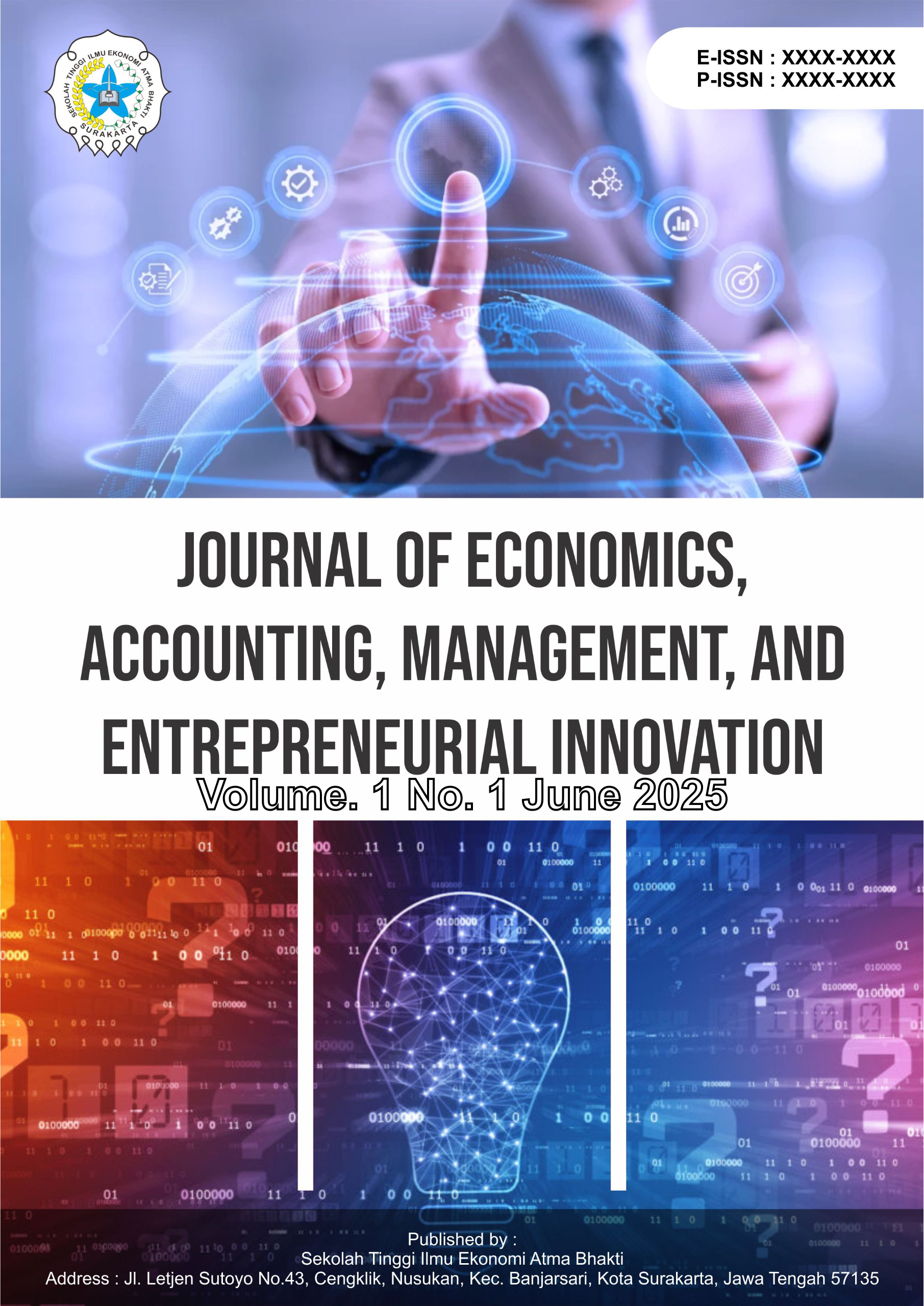Integrating Financial Innovation and Strategic Management: A Pathway to Entrepreneurial Success
Keywords:
Business success, Competitive advantage, Entrepreneurship, Financial innovation, Strategic managementAbstract
In today’s dynamic and competitive global business environment, the integration of financial innovation and strategic management has become a crucial driver of entrepreneurial success. Financial innovation, encompassing new financial products, services, and technological advancements, enhances entrepreneurs’ ability to secure capital, manage risk, and optimize resources. Meanwhile, strategic management provides the framework to align organizational objectives, design adaptive strategies, and sustain long-term growth. This paper examines how the synergy between financial innovation and strategic management fosters resilience, competitiveness, and value creation among entrepreneurs. Recent empirical studies reveal that financial technologies—such as digital payment systems, crowdfunding platforms, blockchain applications, and alternative financing models—help entrepreneurs overcome barriers to funding and expand market opportunities. When effectively managed, these innovations not only support sustainable financial practices but also enhance agility, customer engagement, and differentiation in competitive markets. The integration of financial innovation into strategic planning further enables entrepreneurs to anticipate uncertainties, strengthen decision-making, and achieve scalability. This alignment creates opportunities for sustainable growth by balancing financial efficiency with strategic leadership. As a result, businesses are better equipped to adapt to technological disruptions, changing consumer preferences, and volatile global conditions. Findings suggest that entrepreneurial success in the modern economy relies on the capacity to blend financial innovation with strategic vision. Such integration fosters innovation-driven ecosystems that encourage competitiveness and resilience. The paper concludes that future research should emphasize practical frameworks enabling entrepreneurs to adopt financial innovations while ensuring coherence with organizational strategies. This approach is essential to achieving sustainable competitive advantage and long-term success in an increasingly complex global economy.
References
Adomako, S., Amankwah-Amoah, J., Tarba, S. Y., Khan, Z., & Anning-Dorson, T. (2021). Financial innovation, strategic agility, and entrepreneurial orientation in dynamic environments. International Small Business Journal, 39(4), 288–310. https://doi.org/10.1177/0266242620967006
Agyemang, E. D., Aboagye, E., & Amponsah-Tawiah, K. (2020). Sustainable entrepreneurship and small and medium-sized enterprises (SMEs): A literature review. Sustainability, 12(9), 3785. https://doi.org/10.3390/su12093785
Arner, D. W., Barberis, J., & Buckley, R. P. (2016). The evolution of Fintech: A new post-crisis paradigm? Georgetown Journal of International Law, 47(4), 1271–1319.
Autio, E., Nambisan, S., Thomas, L. D., & Wright, M. (2014). Digital affordances, spatial affordances, and the genesis of entrepreneurial ecosystems. Strategic Entrepreneurship Journal, 8(1), 5–25. https://doi.org/10.1002/sej.1165
Barney, J. (1991). Firm resources and sustained competitive advantage. Journal of Management, 17(1), 99–120. https://doi.org/10.1177/014920639101700108
Beck, T., & Demirguc-Kunt, A. (2006). Small and medium-size enterprises: Access to finance as a growth constraint. Journal of Banking & Finance, 30(11), 2931–2943. https://doi.org/10.1016/j.jbankfin.2006.05.009
Belleflamme, P., Lambert, T., & Schwienbacher, A. (2014). Crowdfunding: Tapping the right crowd. Journal of Business Venturing, 29(5), 585–609. https://doi.org/10.1016/j.jbusvent.2013.07.003
Bocken, N. M. P., Short, S. W., Rana, P., & Evans, S. (2014). A literature and practice review to develop sustainable business model archetypes. Journal of Cleaner Production, 65, 42–56. https://doi.org/10.1016/j.jclepro.2013.11.039
Chen, J., Liu, L., & Zou, H. (2021). Financial innovation and firm performance: Evidence from emerging markets. Journal of Business Research, 124, 493–505. https://doi.org/10.1016/j.jbusres.2020.11.048
Chen, M. A., Wu, Q., & Yang, B. (2019). How valuable is FinTech innovation? The Review of Financial Studies, 32(5), 2062–2106. https://doi.org/10.1093/rfs/hhy130
Creswell, J. W., & Creswell, J. D. (2018). Research design: Qualitative, quantitative, and mixed methods approaches (5th ed.). SAGE.
Davis, F. D. (1989). Perceived usefulness, perceived ease of use, and user acceptance of information technology. MIS Quarterly, 13(3), 319–340. https://doi.org/10.2307/249008
Frame, W. S., & White, L. J. (2004). Technological change, financial innovation, and diffusion in banking. Journal of Money, Credit and Banking, 36(2), 142–166. https://doi.org/10.1353/mcb.2004.0030
Gomber, P., Kauffman, R. J., Parker, C., & Weber, B. W. (2018). On the fintech revolution: Interpreting the forces of innovation, disruption, and transformation in financial services. Journal of Management Information Systems, 35(1), 220–265. https://doi.org/10.1080/07421222.2018.1440766
Hair, J. F., Black, W. C., Babin, B. J., & Anderson, R. E. (2019). Multivariate data analysis (8th ed.). Cengage Learning.
Hill, C. W., Jones, G. R., & Schilling, M. A. (2014). Strategic management: Theory: An integrated approach (11th ed.). Cengage Learning.
Kline, R. B. (2015). Principles and practice of structural equation modeling (4th ed.). Guilford Press.
Lumpkin, G. T., & Dess, G. G. (1996). Clarifying the entrepreneurial orientation construct and linking it to performance. Academy of Management Review, 21(1), 135–172. https://doi.org/10.5465/amr.1996.9602161568
Mollick, E. (2014). The dynamics of crowdfunding: An exploratory study. Journal of Business Venturing, 29(1), 1–16. https://doi.org/10.1016/j.jbusvent.2013.06.005
Nag, R., Hambrick, D. C., & Chen, M. J. (2007). What is strategic management, really? Inductive derivation of a consensus definition of the field. Strategic Management Journal, 28(9), 935–955. https://doi.org/10.1002/smj.615
Nambisan, S., Wright, M., & Feldman, M. (2019). The digital transformation of innovation and entrepreneurship: Progress, challenges and key themes. Research Policy, 48(8), 103773. https://doi.org/10.1016/j.respol.2019.03.018
Porter, M. E. (1985). Competitive advantage: Creating and sustaining superior performance. Free Press.
Rogers, E. M. (2003). Diffusion of innovations (5th ed.). Free Press.
Saunders, M., Lewis, P., & Thornhill, A. (2019). Research methods for business students (8th ed.). Pearson.
Teece, D. J. (2010). Business models, business strategy and innovation. Long Range Planning, 43(2–3), 172–194. https://doi.org/10.1016/j.lrp.2009.07.003
Teece, D. J., Pisano, G., & Shuen, A. (1997). Dynamic capabilities and strategic management. Strategic Management Journal, 18(7), 509–533. https://doi.org/10.1002/(SICI)1097-0266(199708)18:7
Tufano, P. (2003). Financial innovation. In G. M. Constantinides, M. Harris, & R. M. Stulz (Eds.), Handbook of the Economics of Finance (Vol. 1, pp. 307–335). Elsevier. https://doi.org/10.1016/S1574-0102(03)01010-0
Zhang, J. A., & Van Auken, H. (2020). Entrepreneurial finance and the role of financial innovation: Evidence from emerging markets. Journal of Small Business Management, 58(5), 905–931. https://doi.org/10.1080/00472778.2019.1659675




